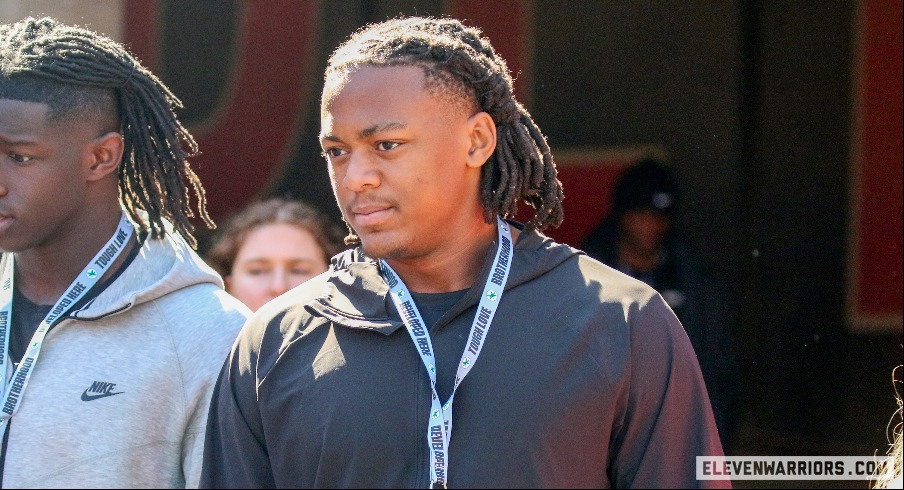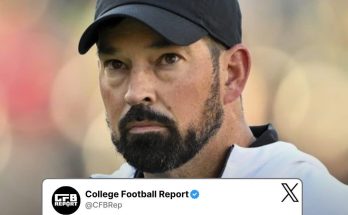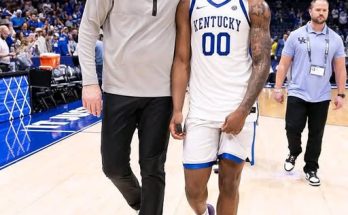Another blow landed in Columbus on Friday, and it stung. Ohio State, a school long synonymous with churning out elite defensive ends, missed on yet another prized edge rusher in the 2025 class as four-star talent KJ Ford gave his verbal commitment to the University of Florida. For Ryan Day and his staff, it marked the latest disappointment in a recruiting cycle that’s beginning to raise serious questions about the Buckeyes’ ability to lock in elite pass rushers — a cornerstone of their defensive identity for over a decade.
KJ Ford, a 6-foot-4, 240-pound edge menace from Alabama’s St. James School, had emerged as one of the most coveted defensive ends in the country. Possessing a rare combination of bend, burst, and hand technique, Ford represented a foundational type of player for any Power Five program looking to control the line of scrimmage. His junior tape was a highlight reel of violent hands, relentless pursuit, and natural instincts. He was seen not just as a playmaker but as a tone-setter — a culture-defining defender. So when he pulled the trigger and picked Florida over Ohio State, Tennessee, and Texas, it wasn’t just a recruiting loss. It was a signal flare.
Ohio State has traditionally been “Defensive End U.” From the Bosa brothers to Chase Young, and with Larry Johnson widely regarded as the best defensive line coach in the country for years, the Buckeyes established a pipeline to the NFL that few could rival. Their recruiting board rarely missed. But the past few cycles have told a different story — one where the Buckeyes consistently fall just short for the top-tier edge rushers. KJ Ford’s commitment to Florida isn’t an isolated incident; it’s part of a growing pattern.
In 2023, Ohio State struck out on five-star defensive end Keon Keeley, who flipped to Alabama. In 2024, they made a strong push for top edge Elijah Rushing before he too turned away. Now, with Ford’s pledge to Florida, the Buckeyes find themselves without a top-100 edge rusher in the fold for 2025 — a sobering reality for a program that once seemed to handpick NFL-bound pass rushers with ease.
The optics of losing Ford to Florida only adds to the weight. The Gators have been struggling on the field under Billy Napier, and while their NIL operation has clearly picked up steam, they are not yet seen as the dominant brand Ohio State is. Yet recruits like Ford are choosing them anyway. That raises important questions about what today’s high-profile recruits value. Is it proximity to home? NIL guarantees? Coaching relationships? Immediate playing time? For Ohio State, which has banked on tradition, player development, and NFL pedigree, the shift in recruiting dynamics might be catching them flat-footed.
There’s also the matter of Larry Johnson, the legendary defensive line coach who has mentored superstars but is now in his early 70s. While still respected in football circles, Johnson’s future with the program is a yearly topic of speculation. Recruits and their families — especially those looking for multi-year development — want assurance that their position coach will be around for the duration of their college careers. In that regard, the uncertainty surrounding Johnson’s tenure might be having a subtle but real effect on Ohio State’s ability to close on top defensive ends.
The program has made recent moves to adapt to this new recruiting era, including expanding its NIL efforts, bolstering its recruiting staff, and pushing for greater early engagement with underclassmen. But for a school like Ohio State, which doesn’t just aspire to win Big Ten titles but national championships, these moves must produce results quickly. Missing out on a player like Ford isn’t simply a matter of one less name on the commitment list — it’s a potential difference-maker gone to a competitor.
One could argue the loss of Ford won’t truly be felt until fall Saturdays in 2026 or 2027, when he’s coming off the edge in a Gator uniform and Ohio State is looking for sacks in crucial playoff games. But the real danger for Ohio State isn’t just missing on Ford. It’s the possibility that a trend is forming. Top defensive line prospects are looking elsewhere. And once momentum shifts in recruiting, it can be hard to reverse course.
Adding to the challenge is the increased competition from southern schools who are surging both on the trail and in the NIL arms race. SEC programs like Florida, Tennessee, and Georgia have recruited the position with growing success, often leveraging proximity, branding, and strong NIL collectives to edge out schools like Ohio State. In the old model, a school with Ohio State’s track record could walk into any living room and sell “We’re different. We’ll make you great.” Today, that message competes with “We’ll pay you now, and you’ll still get developed.” For players like KJ Ford, who may feel both paths are viable, the scales can tip away from tradition.
Ohio State still has time to recover in the 2025 cycle. Targets remain, and it’s possible that a top-50 edge rusher still lands in Columbus. But the recent string of misses is undeniably concerning. The coaching staff’s ability to pivot — both strategically and rhetorically — will be put to the test. They may need to hit the portal more aggressively. They may need to recalibrate their pitch. Or, perhaps most importantly, they may need to offer clarity about the future of their defensive coaching infrastructure, particularly at defensive line.
None of this is to suggest Ohio State’s program is unraveling. Far from it. They’re still elite at several positions and continue to bring in high-end talent across the board. Their 2025 class still ranks among the nation’s best. But every elite team has keystone positions — spots where they simply must dominate to compete at the highest level. For Ohio State, edge rusher is one of them. Their success in the 2010s was predicated on quarterback pressure, havoc plays, and freaks off the edge. Chase Young didn’t just help them win games — he shaped their identity. So did Nick and Joey Bosa. When those names are no longer being replaced by talents of similar caliber, the team begins to lose its defining edge — both literally and figuratively.
Recruiting is never about a single win or loss. It’s about patterns, trajectories, and trends. KJ Ford choosing Florida might not be a catastrophe in isolation. But if it’s part of a broader momentum shift — one where top pass rushers are increasingly choosing southern powers or more aggressive NIL bidders — then Ohio State has real work to do. The Buckeyes have long been a standard-bearer of defensive excellence. Now, they must fight to protect that legacy.
The pressure is on. Not in the panic sense, but in the urgency sense. Recruits pay attention to results, and if Ohio State’s pass rush struggles this fall, it could exacerbate the perception that the program is slipping in its ability to develop elite edge talent. But the opposite is also true: if a returning player like Jack Sawyer or Kenyatta Jackson breaks out, the Buckeyes can point to development and production as evidence that they haven’t lost their touch. In recruiting, perception becomes reality fast.
It’s clear that missing on KJ Ford was a tough blow for Ryan Day and his staff. They invested time, resources, and relationships into landing him. But now, they must pivot. The future of Ohio State’s defense depends on how they respond — not just with one player, but with a recalibrated vision for what it means to be a Buckeye defensive lineman in 2025 and beyond. The competition isn’t slowing down, and the stakes — both on the field and in the recruiting war rooms — are only getting higher.



